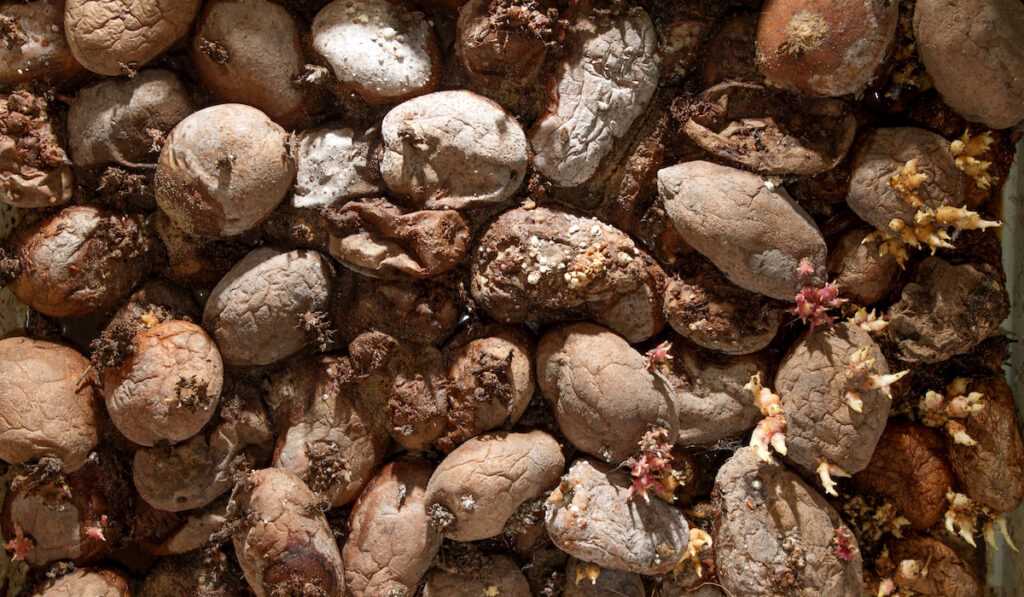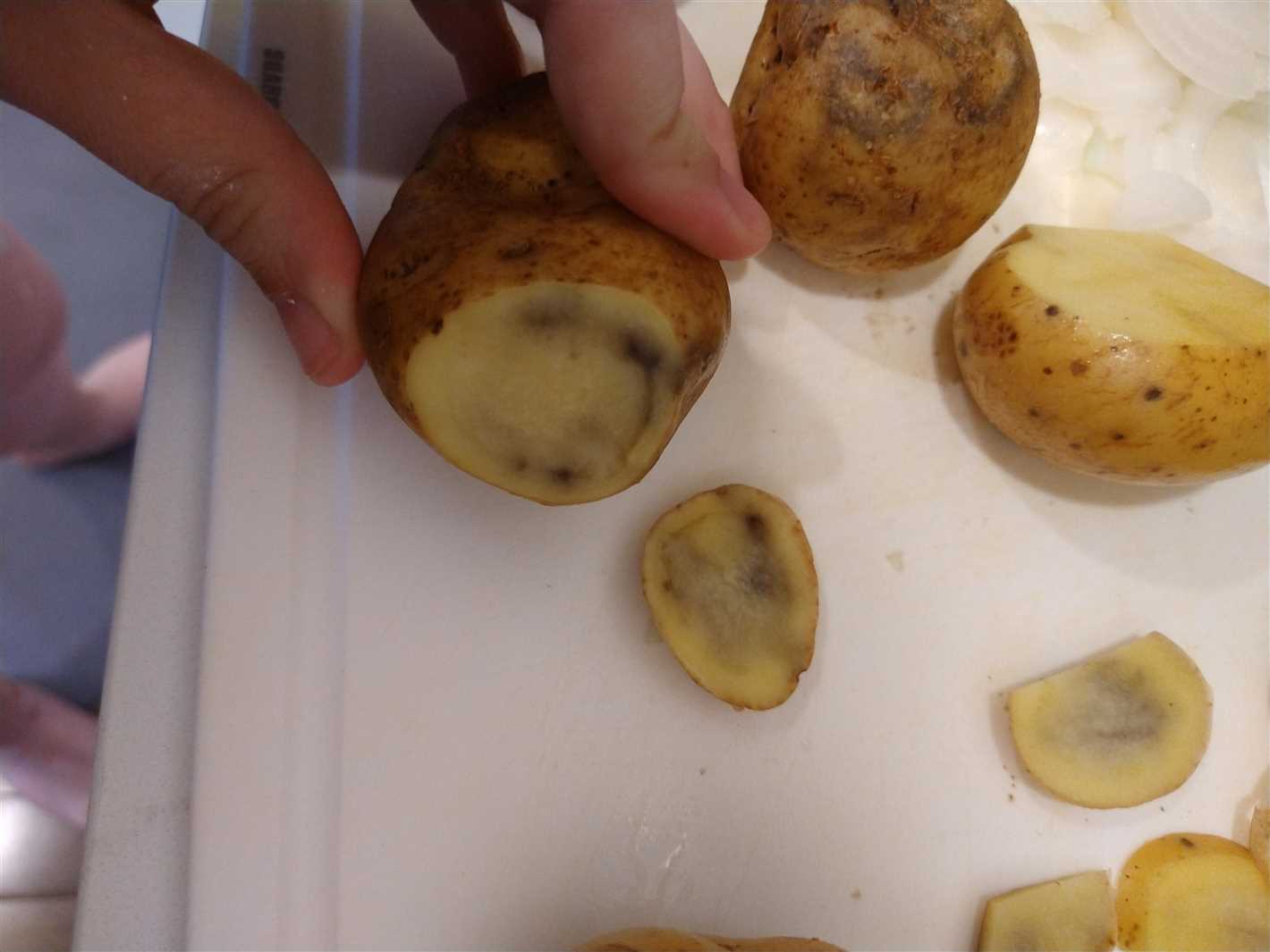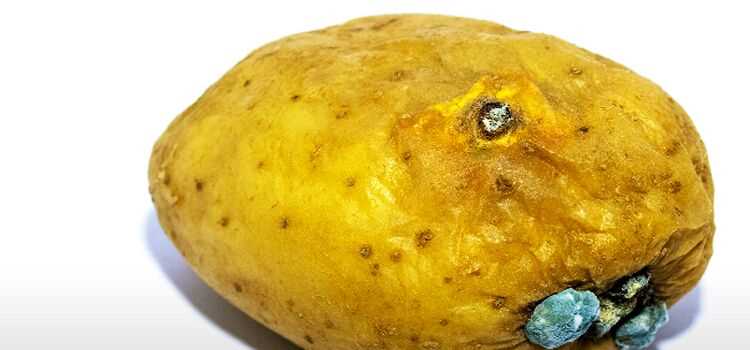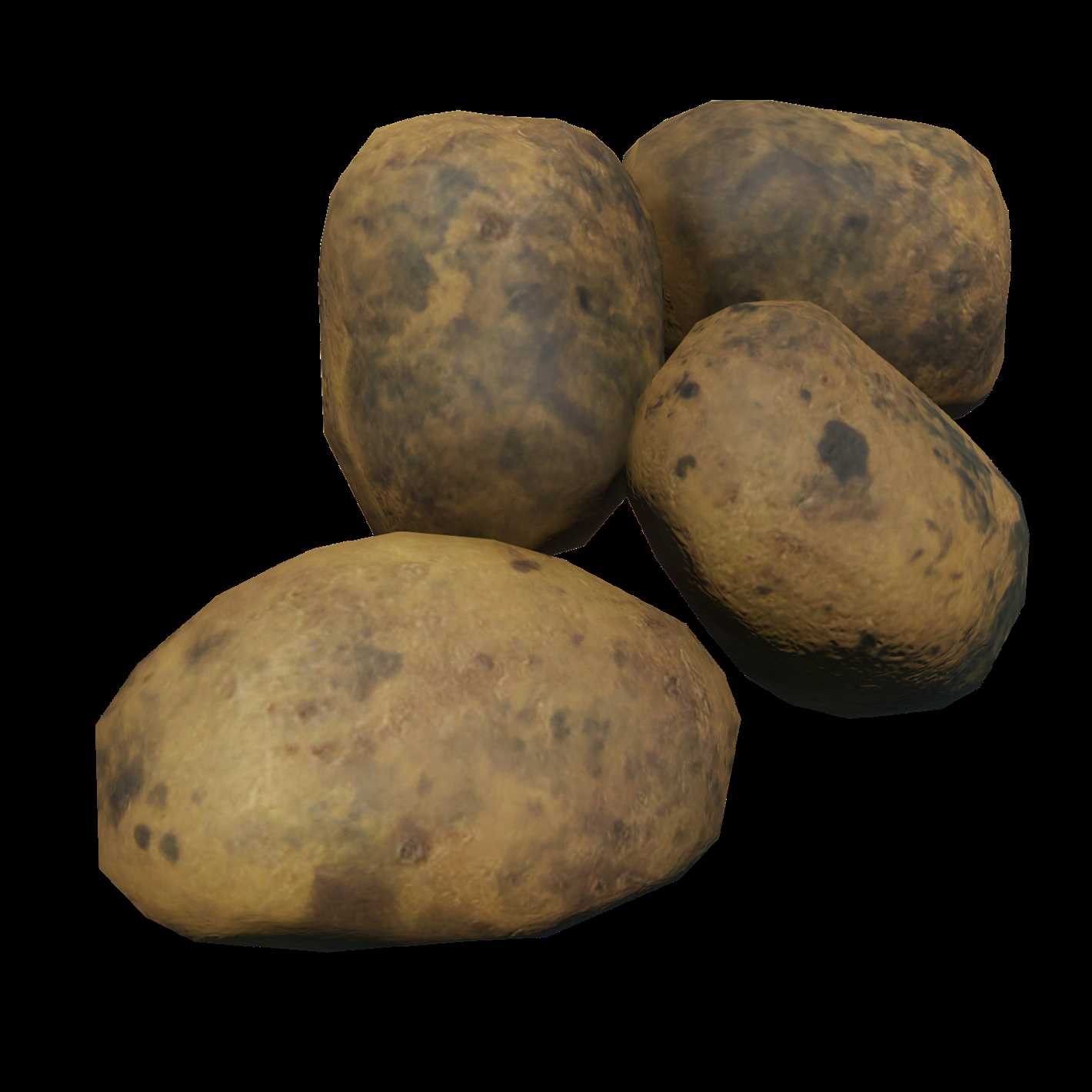- Understanding the Potato Life Cycle
- 1. Planting Potatoes
- 2. Sprouting and Vegetative Growth
- 3. Flowering and Pollination
- 4. Formation of Potatoes
- 5. Maturation and Harvest
- 6. Dormancy and Storage
- 7. New Cycle Begins
- Conclusion
- Common Causes of Rotten Potatoes
- 1. Poor Storage Conditions
- 2. Damaged Potatoes
- 3. Improper Harvesting
- 4. Disease and Pathogens
- 5. Improper Handling and Transportation
- Effective Storage Techniques to Prevent Rot
- Identifying and Treating Rotten Potatoes
- 1. External inspection:
- 2. Internal inspection:
- 3. Treating rotten potatoes:
- 4. Preventive measures:
- High-Quality Potatoes: Tips for Selection and Preparation
- Selection:
- Preparation:
- Storage:
- Creative Recipes Using Rotten Potatoes
- Potato Pancakes
- Potato Soup
- Potato Gnocchi
- Innovative Ways to Repurpose Rotten Potatoes
- 1. Homemade Potato Fertilizer
- 2. Natural Dye
- 3. Potato Starch
- 4. Animal Feed
- 5. Biogas Production
- 6. Potato Skin Snacks
- Conclusion
- Sustainable Solutions for Reducing Potato Waste
- 1. Efficient Harvesting Techniques
- 2. Proper Storage Facilities
- 3. Improved Sorting and Grading Systems
- 4. Value-Added Product Development
- 5. Collaboration and Education
- “Question-Answer”
- What are some common causes of potatoes rotting?
- How can I prevent potatoes from rotting?
- Can I still eat potatoes that have started to rot?
- What can I do with rotten potatoes?
- Are there any ways to salvage slightly rotten potatoes?
- “Video” 8 POWERFUL HOMEMADE ROOTING HORMONES| Natural Rooting Stimulants for Gardening
Have you ever opened your pantry to find a bag of rotten potatoes? Instead of throwing them away, why not transform these seemingly unusable vegetables into high-quality tubers? By following a few simple steps, you can reduce waste and maximize the potential of your potatoes.
First, it’s important to identify the rotten potatoes. Look for signs of decay, such as soft spots, mold, or a foul smell. These potatoes are not suitable for consumption and should be separated from the rest. However, don’t be too quick to discard them as they can still serve a purpose in your garden.
To transform rotten potatoes into high-quality tubers, you can turn them into compost. Composting is a natural process that breaks down organic matter into nutrient-rich soil. It not only reduces waste but also provides a sustainable source of fertilizer for your garden. Simply chop the rotten potatoes into smaller pieces and add them to your compost pile. Make sure to mix them with other organic materials like leaves, grass clippings, and vegetable scraps to create a balanced compost mixture.
Another option for utilizing rotten potatoes is by making potato starch. Potato starch is a versatile ingredient that can be used in various recipes, such as baking, thickening soups and sauces, or making homemade playdough. To make potato starch, peel the rotten potatoes and cut them into small cubes. Place the cubes in a pot with enough water to cover them, then bring to a boil. Once the potatoes are soft, strain the mixture and collect the starchy liquid. Let it cool and settle, then carefully pour out the excess water, leaving behind the starch sediment. Allow the sediment to dry, and you’ll have homemade potato starch ready to be used in your favorite recipes.
Tip: If you’re short on time or don’t have the resources to transform rotten potatoes, consider donating them to local farms or animal shelters. Many farmers and pet owners can use them as animal feed, preventing even more waste and ensuring that the potatoes serve a purpose.
So, the next time you come across a bag of rotten potatoes, don’t be discouraged. With a little effort and creativity, you can turn them into high-quality tubers or donate them for a beneficial purpose. By minimizing waste in your kitchen, you’ll not only save money but also contribute to a more sustainable future.
Understanding the Potato Life Cycle
Before diving into methods to transform rotten potatoes into high-quality tubers, it’s important to have a basic understanding of the potato life cycle. By understanding the stages a potato goes through from planting to harvest, we can better comprehend the various factors that contribute to the overall quality of the harvested tubers.
1. Planting Potatoes
The potato life cycle begins with planting. Potatoes are typically planted as whole tubers or pieces of tubers known as seed potatoes. These seed potatoes contain the necessary nutrients and dormant buds (known as “eyes”) that will sprout and give rise to new potato plants.
2. Sprouting and Vegetative Growth
After planting, the potato tubers begin to sprout and give rise to new vegetative growth. From the eyes of the seed potatoes, sprouts emerge and develop into green stems and leaves. During this stage, it is crucial to provide adequate water, nutrients, and sunlight to promote healthy growth.
3. Flowering and Pollination
Once the potato plants reach maturity, they enter the flowering stage. The plants produce attractive white or purple flowers that typically last for a short period. These flowers attract pollinators such as bees, which play a vital role in the pollination process and the formation of potato fruits.
4. Formation of Potatoes
After successful pollination, the potato plants allocate energy towards the development of underground tubers. Stolons, which are specialized stems, start swelling and forming small potato tubers. These tubers gradually increase in size as the plant continues to photosynthesize and store energy.
5. Maturation and Harvest
As the potato tubers mature, the above-ground foliage starts to wither and yellow. This signals that the potatoes are ready for harvest. It’s essential to wait until the tubers are adequately matured to ensure optimal size, texture, and flavor. Harvesting at the right time is crucial to maximize the quality of the harvested potatoes.
6. Dormancy and Storage
After harvesting, the potato tubers enter a dormant state. Proper storage conditions, including a cool and dark environment, help maintain the quality and prevent sprouting. By ensuring suitable storage conditions, it is possible to minimize waste and extend the lifespan of the harvested potatoes.
7. New Cycle Begins
The stored potatoes can then be used as seed potatoes for the next planting cycle, starting the potato life cycle all over again.
Conclusion
Understanding the potato life cycle provides valuable insights into the various stages a potato undergoes from planting to harvest. This knowledge is essential when it comes to optimizing growing conditions, harvesting at the right time, and storing potatoes properly to minimize waste and produce high-quality tubers.
Common Causes of Rotten Potatoes
Potatoes are a versatile and nutritious vegetable that can be used in a variety of dishes. However, they are also prone to rotting if not stored properly or if certain conditions are present. Here are some common causes of rotten potatoes:
1. Poor Storage Conditions

- Potatoes should be stored in a cool, dark, and well-ventilated area.
- Exposure to sunlight can cause greening, which leads to a bitter taste and can promote rotting.
- High humidity can create a moist environment that encourages the growth of mold and bacteria.
- Potatoes should be stored away from other fruits and vegetables, as they release ethylene gas, which accelerates the ripening process and can lead to faster spoilage.
2. Damaged Potatoes
Potatoes with cuts, bruises, or other damage are more susceptible to rotting.
- These damaged areas provide entry points for bacteria and fungi.
- It is important to inspect potatoes before storage and discard any that show signs of damage.
3. Improper Harvesting
If potatoes are not harvested properly, they can be more prone to rotting.
- Potatoes should be allowed to mature fully before harvesting to ensure they have a thick skin that can resist disease and rot.
- Harvesting potatoes when the soil is too wet can lead to soil-borne diseases, which can cause rotting.
4. Disease and Pathogens
Various diseases and pathogens can cause potatoes to rot.
- Common diseases include late blight, early blight, and blackleg.
- These diseases can be spread through infected seed potatoes, contaminated soil, or poor crop rotation practices.
- Proper disease management and prevention measures, such as using disease-resistant potato varieties and practicing good crop rotation, can help minimize the risk of rotting.
5. Improper Handling and Transportation
Potatoes can be damaged during handling and transportation, leading to rotting.
- Rough handling can cause bruising and other damage.
- Potatoes should be handled gently and stored in appropriate containers to protect them from excessive pressure and impact.
- Proper temperature and ventilation should be maintained during transportation to prevent the growth of bacteria and fungi.
By understanding these common causes of rotten potatoes, you can take the necessary steps to minimize waste and ensure you have high-quality tubers for your recipes.
Effective Storage Techniques to Prevent Rot
Proper storage techniques are crucial in preventing the rotting of potatoes. Here are some effective methods to ensure that your potatoes remain fresh for a longer period:
- Store in a cool, dark place: Potatoes should be stored in a cool, dark space with a temperature between 45-50 degrees Fahrenheit (7-10 degrees Celsius). Avoid storing them near sources of heat or direct sunlight.
- Avoid exposure to moisture: Moisture can accelerate the rotting process. Ensure that the storage area is dry and well-ventilated to prevent the build-up of excess humidity.
- Avoid storing with other vegetables or fruits: Potatoes release ethylene gas, which can cause nearby produce to ripen faster and spoil. It is best to store potatoes separately from other vegetables and fruits.
- Inspect and remove any rotten potatoes: Regularly check for any signs of rot or decay in your potato storage. If you find any rotten potatoes, remove them immediately to prevent the spread of rot to other potatoes.
- Use proper containers: Avoid storing potatoes in plastic bags, as they can trap moisture and lead to rot. Instead, use breathable containers, such as baskets, paper bags, or mesh bags, that allow air circulation.
- Avoid washing potatoes before storage: Washing potatoes before storage can make them more susceptible to rot. Only clean them right before cooking.
By following these effective storage techniques, you can minimize waste and extend the shelf life of your potatoes, ensuring that they remain of high quality for longer periods of time.
Identifying and Treating Rotten Potatoes

Identifying rotten potatoes is crucial to minimizing waste and ensuring that only high-quality tubers are used. Here are some steps to help you identify and treat rotten potatoes:
1. External inspection:
- Look for any visible signs of rot on the potato’s skin. This can include dark patches, soft spots, or a foul odor.
- If the skin appears wrinkled or shriveled, it may indicate that the potato is dehydrated and potentially rotting.
- Check for any mold or fungal growth, which can be a sign of rot.
2. Internal inspection:
- Slice the potato open to check its texture and color.
- Healthy potatoes should have a firm texture and a uniform color throughout.
- If you notice any sliminess, discoloration, or a bad odor, it indicates internal rot.
3. Treating rotten potatoes:
Once you’ve identified a rotten potato, it’s essential to take appropriate measures to prevent further contamination:
- Separate the rotten potatoes from the healthy ones to prevent the spread of decay.
- Dispose of the rotten potatoes in a sealed bag or container to avoid attracting pests or spreading fungi.
- Ensure proper ventilation and storage conditions to prevent moisture buildup, which can contribute to potato rot.
- Regularly inspect stored potatoes to identify any signs of rot and remove them promptly.
4. Preventive measures:
Preventing potato rot is crucial in minimizing waste. Here are some preventive measures to adopt:
- Avoid storing potatoes in damp or humid environments.
- Keep potatoes in a cool, dark, and well-ventilated area.
- Regularly check stored potatoes for signs of decay.
- Avoid rough handling of potatoes, as this can bruise them and create entry points for rot-causing organisms.
- Use proper post-harvest handling techniques, including curing and proper storage conditions.
By following these steps and implementing preventive measures, you can effectively identify and treat rotten potatoes, reducing waste and ensuring the use of high-quality tubers.
High-Quality Potatoes: Tips for Selection and Preparation
Potatoes are a versatile and nutritious vegetable that can be enjoyed in a variety of dishes. To ensure that you are using high-quality potatoes, it is important to know how to select and prepare them properly. Follow these tips to make the most of your potatoes:
Selection:
- Choose potatoes that are firm and free from sprouts or green spots. These signs indicate that the potatoes are past their prime.
- Look for potatoes with smooth, unblemished skin. Avoid potatoes with cuts, bruises, or soft spots as they may be rotten inside.
- Consider the type of potato you need for your recipe. Russet potatoes are great for baking and mashing, while waxy potatoes like Yukon Gold or red potatoes are better for boiling and roasting.
Preparation:
- Before using your potatoes, thoroughly rinse them under cold water to remove any dirt or debris.
- Peel the potatoes if desired or leave the skins on for added nutrients and texture.
- If you choose to peel the potatoes, use a vegetable peeler and remove a thin layer of skin. Be careful not to remove too much, as many of the nutrients are located just below the skin.
- Cut the potatoes into the desired shape. For mashed potatoes, cut them into smaller pieces to cook more quickly and evenly.
- If you are boiling the potatoes, place them in a large pot and cover with cold water. Add salt to the water for added flavor.
- If you are roasting or baking the potatoes, toss them in olive oil, salt, and your favorite herbs or spices before placing them in the oven.
Storage:
To prevent your potatoes from spoiling, store them in a cool, dark, and well-ventilated place. Avoid storing them in plastic bags, as this can cause them to rot faster. Keep them away from onions as they can speed up spoilage.
By following these tips for selecting and preparing high-quality potatoes, you can ensure that your dishes turn out delicious every time.
Creative Recipes Using Rotten Potatoes

Don’t let your rotten potatoes go to waste! There are plenty of creative ways to transform them into delicious dishes. Here are a few recipes to try:
Potato Pancakes
Ingredients:
- Rotten potatoes
- 1 onion
- 2 eggs
- 1/4 cup flour
- Salt and pepper to taste
Instructions:
- Grate the potatoes and onion.
- Squeeze out any excess moisture from the grated potatoes and onion.
- In a bowl, mix together the grated potatoes, onion, eggs, flour, salt, and pepper.
- Heat some oil in a frying pan over medium heat.
- Spoon the potato mixture into the pan and flatten to form pancakes.
- Cook for a few minutes on each side until golden brown.
- Serve with sour cream or applesauce.
Potato Soup

Ingredients:
- Rotten potatoes
- 1 onion
- 2 cloves of garlic
- 4 cups vegetable or chicken broth
- 1 cup milk or cream
- Salt and pepper to taste
Instructions:
- Chop the potatoes, onion, and garlic.
- In a large pot, sauté the onion and garlic until fragrant.
- Add the potatoes and broth to the pot.
- Bring to a boil, then reduce heat and simmer until the potatoes are tender.
- Use an immersion blender or blender to puree the soup until smooth.
- Stir in the milk or cream and season with salt and pepper.
- Simmer for a few more minutes until heated through.
- Serve hot with crusty bread.
Potato Gnocchi
Ingredients:
- Rotten potatoes
- 1 egg
- 1 1/2 cups flour
- Salt and pepper to taste
Instructions:
- Boil the potatoes until they are easily pierced with a fork.
- Drain and let cool slightly, then peel the potatoes.
- Mash the potatoes until smooth.
- In a large bowl, mix together the mashed potatoes, egg, flour, salt, and pepper until a dough forms.
- Divide the dough into small portions and roll each portion into a rope shape.
- Cut the ropes into small pieces to form the gnocchi.
- Bring a pot of salted water to a boil.
- Add the gnocchi to the boiling water and cook until they rise to the surface.
- Drain the gnocchi and serve with your favorite sauce.
These recipes are just a few examples of how you can turn rotten potatoes into tasty dishes. Get creative and experiment with different flavors and ingredients to make the most out of your potatoes, even when they’re past their prime!
Innovative Ways to Repurpose Rotten Potatoes
When potatoes start to go bad, many people are quick to throw them away. However, there are several creative and useful ways to repurpose rotten potatoes, saving money and minimizing waste. Here are some innovative ideas to consider:
1. Homemade Potato Fertilizer
Rotten potatoes can be composted and used to create homemade potato fertilizer. Simply cut the potatoes into small pieces and add them to your compost pile. Over time, the potatoes will break down and enrich the soil with nutrients, helping to nourish your plants and promote healthy growth.
2. Natural Dye
If you enjoy arts and crafts, repurposing rotten potatoes as a natural dye can be a fun and sustainable project. Boil the potatoes until they become soft and mash them into a paste. Use the resulting liquid as a dye to color fabrics, yarn, or even Easter eggs. Experiment with different potato varieties for unique shades of color.
3. Potato Starch
Rotten potatoes can still be processed to extract starch, which has various culinary and non-food applications. Peel the rotten potatoes and cut them into small pieces. Blend the pieces with water until a smooth consistency is achieved. Strain the mixture through a cheesecloth or fine mesh sieve to separate the starch. The starch can then be used as a natural thickening agent in cooking or as a homemade adhesive.
4. Animal Feed
Rotten potatoes can also serve as a source of nutrition for livestock. While not suitable for human consumption, they can be boiled or mashed to create a nutritious and cost-effective feed for animals such as pigs or chickens. This is a sustainable way to repurpose rotten potatoes while reducing feed expenses.
5. Biogas Production
Rotten potatoes can be used as a substrate for biogas production. With the help of anaerobic bacteria, potatoes can be transformed into methane-rich biogas. This biogas, in turn, can be used as a renewable energy source for heating, cooking, or electricity generation. This method not only repurposes rotten potatoes but also contributes to reducing greenhouse gas emissions.
6. Potato Skin Snacks
Instead of discarding the peel of rotten potatoes, try turning them into a tasty and nutritious snack. Wash the potato skins thoroughly and bake them in the oven until crispy. Season them with salt, pepper, or your favorite spices. These homemade potato skin snacks are a healthy alternative to store-bought chips and can be enjoyed guilt-free.
Conclusion
There are countless innovative ways to repurpose rotten potatoes, from using them as fertilizer and natural dye to producing biogas and creating tasty snacks. By exploring these options, you can minimize waste, save money, and embrace a sustainable lifestyle.
Sustainable Solutions for Reducing Potato Waste
Potatoes are one of the most commonly consumed vegetables globally, but they are also a significant source of food waste. However, there are several sustainable solutions to reduce potato waste and minimize their environmental impact.
1. Efficient Harvesting Techniques
Implementing efficient harvesting techniques can help minimize potato waste. For example, using mechanical harvesters that carefully lift potatoes from the ground can prevent damage and reduce the likelihood of bruising or rotting. This can ensure that a higher percentage of harvested potatoes meet the quality standards for consumption.
2. Proper Storage Facilities
Investing in proper storage facilities is essential for reducing potato waste. These facilities should provide optimum temperature, humidity, and ventilation control to extend the shelf life of potatoes. Additionally, implementing technologies such as ethylene control systems can help prevent sprouting and spoilage.
3. Improved Sorting and Grading Systems
Implementing advanced sorting and grading systems can help identify and separate potatoes with defects or signs of spoilage. This allows farmers and food processors to remove substandard potatoes before they reach consumers, reducing the amount of waste generated.
4. Value-Added Product Development
Exploring value-added product development can help utilize imperfect or surplus potatoes that would otherwise go to waste. For example, turning these potatoes into potato chips, fries, mashed potatoes, or dehydrated products can extend their shelf life and create additional revenue streams.
5. Collaboration and Education
Collaboration between farmers, retailers, and consumers is crucial for reducing potato waste. Educating consumers about proper storage and handling techniques, as well as raising awareness about the environmental consequences of potato waste, can encourage responsible consumption and minimize unnecessary discard.
| Environmental Benefits | Economic Benefits | Social Benefits |
|---|---|---|
|
|
|
By implementing these sustainable solutions, we can significantly reduce potato waste and create a more efficient and environmentally friendly potato industry.
“Question-Answer”
What are some common causes of potatoes rotting?
There are several common causes of potato rotting. One main cause is excessive moisture, which can lead to the growth of bacteria and fungi. Another cause is injury to the potatoes, such as cuts or bruises, which can provide an entry point for pathogens. Improper storage conditions, such as high temperatures or exposure to sunlight, can also contribute to potato rotting.
How can I prevent potatoes from rotting?
There are several steps you can take to prevent potatoes from rotting. First, make sure to store them in a cool, dark and well-ventilated place. Avoid storing potatoes near other fruits or vegetables, as they can produce ethylene gas which speeds up the rotting process. It’s also important to handle potatoes with care and avoid any damage that could lead to rotting. Lastly, always check and remove any rotten potatoes from the batch to prevent the spread of rot.
Can I still eat potatoes that have started to rot?
It is not recommended to eat potatoes that have started to rot, as they may contain harmful bacteria or toxins. When a potato starts to rot, it usually becomes soft, discolored and emits a foul odor. Consuming such potatoes can lead to food poisoning. It is best to discard any rotten potatoes to avoid any potential health risks.
What can I do with rotten potatoes?
Even though rotten potatoes are not suitable for consumption, they can still be put to good use. One option is to use them for composting. Rotten potatoes are rich in organic matter and can contribute to the nutrient content of the compost. Another option is to use them for gardening. Rotten potatoes can be buried in the soil to release nutrients and improve its quality. If you have livestock, such as pigs or chickens, they can also be fed with rotten potatoes as a treat.
Are there any ways to salvage slightly rotten potatoes?
If a potato is only slightly rotten and the rot has not spread extensively, it may be possible to salvage it. First, carefully remove any visible rot and cut away any portions that are soft or discolored. Afterward, wash the potato thoroughly. If the remaining parts appear healthy, you can proceed to cook or use them in your recipe. However, it’s important to note that salvaging slightly rotten potatoes carries some risk, so it’s recommended to err on the side of caution and discard heavily rotten portions.







